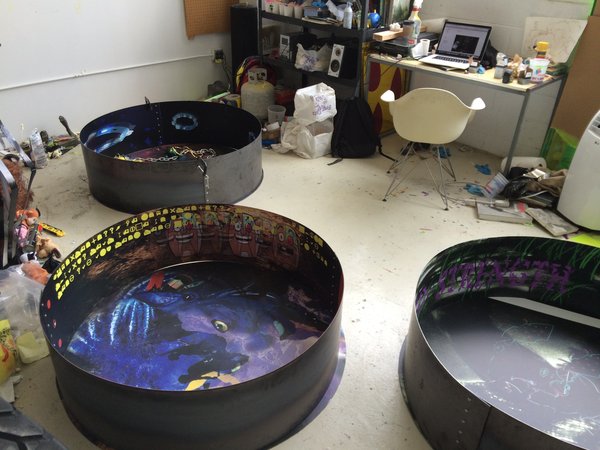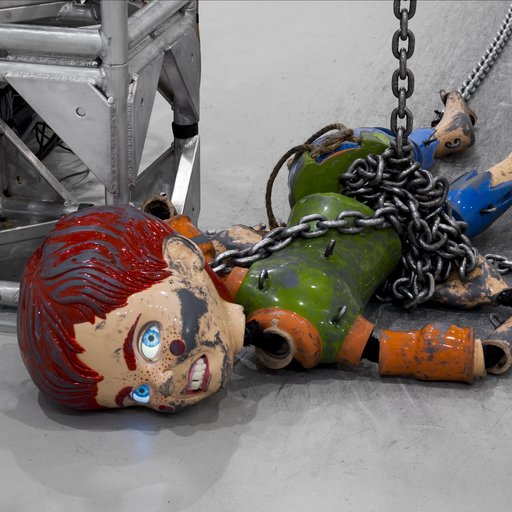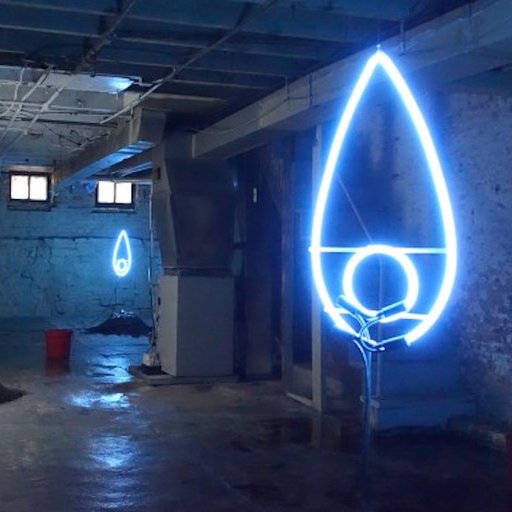Ajay Kurian is an artist, curator, and writer who shows with New York's 47 Canal Gallery. This is the first installment of his new column, Jottings.
A few months back, I was invited to be a part of a public art project that the curators Ruba Katrib and Tom Eccles were organizing on Governors Island. Entitled “The Visitors,” the exhibition was to focus on fantasy, sci-fi scenarios, and strange encounters in a way that would marry well with the strangeness of the island itself. This certainly sounded appropriate for the territory my work has been exploring, and it was a great opportunity to work with Tom and Ruba. I was also excited by the chance to make my idea of public sculpture and engage with an audience that’s largely unrelated to the art world. While this was new terain for me as an artist, I had faith in my fabrication abilities, my understanding of materials, and my experience.
My faith, as I quickly found, was misplaced.

The first step in creating a piece for this show was to simply begin a dialogue regarding what was feasible. My proposal was two-pronged. For the main component, I wanted to construct three new sculptures that would resemble kiddie pools. The foam-covered exteriors would be sculpted into various animal-like totems, the interiors covered in vinyl that I printed with images, and the basins filled with a few particular objects that would form a loose, dissonant, atmospheric narrative.
The pools came out of my ongoing thoughts on childhood, images, and abstraction. Despite some parents believing that their children might grow up pure if shielded from television, movies, and so on, it’s inevitable today that everyone is immersed in images and current culture from infancy onward. I wanted to see how the life of a child and the life of an image might be intertwined. I was also interested to see if any image could outgrow its context or be abstracted when the context of the image is highly overdetermined.
And so each pool was made to mark a moment in Leni Riefenstahl’s career, with their vinyl printed with some appropriated and recast images from her work digitally collaged into various other images, from Katy Perry to Maxfield Parrish. The other component was a set of clear plastic cups, to be distributed for use among all of the island’s vendors, that would have an altered logo of the Voluntary Human Extinction Movement.
 The pools in progress (take #1)
The pools in progress (take #1)
As I began production, Tom and Ruba remained responsive, alert, and interested. Yet they also began to express some doubts. These pieces needed to be very durable, they said. Small elements would almost certainly get broken. Soft objects would quickly degrade. Anything not properly secured would be stolen. These, I now know, were rather standard and fair admonitions. I ignored them all.
There was also a more fundamental problem. Each pool would be made of two pieces of steel—a thick circular sheet of steel forming the base and a thinner band of steel bent into a circle, bolted together, and secured onto the base to make up the walls. The challenge was how to apply the vinyl to the steel and secure the pieces to make a watertight container. It was my impression that the vinyl would need to be applied to a flat surface, so I had to find a way to seamlessly attach the two surfaces after the vinyl had been applied, meaning that I could not weld the two pieces together beforehand. I decided that a fiberglass epoxy putty would be more than strong enough to do the job.
 The sculpted foam exteriors being added
The sculpted foam exteriors being added
Just to make sure, however, I consulted with a fabrication specialist about my predicament. He said that if I were to pour a generous amount of Crystal Clear—a transparent two-part polyurethane that would be invisible to the viewer—into the bottom of the pool, over the putty, I shouldn’t have any trouble. I attempted this… over and over again, each time horrified and frustrated at the appearance of thousands of tiny bubbles, which reduced the clarity significantly.
Having long worked with unusual materials, I am accustomed to working through trial and error, and to material malfunctions, but this was a whole new level of failure. I went back to the studio day after day, pouring more and more Crystal Clear, only to rip out the successive layers when the bubbles emerged like an unstoppable fungus and try again. Gradually I realized that my problem lay in the outrageous humidity that had hit in June, and that there wasn’t much hope of getting a perfectly clear coat.
Finally, equipped with an expensive new air conditioner, I poured about a half inch in each and got what I believed was the clearest coat I could achieve. The pools were sealed. By then my body had been chemically burned from the neck down to my arms. I had cried a bit, not from the pain but from the sheer browbeating impossibility of a project I thought I had figured out. Yet now all was complete, and the pools finally made it to the island just days before they were supposed to arrive.
 The black Muppet cop pool in the studio
The black Muppet cop pool in the studio
Once placed on their stone pedestals, they looked like distant cultural cousins—evincing a relation but without the bloodwork. The first pool glistened like white glazed ceramic with several blades of neon green plexi standing tall to suggest water reeds; custom-made LEGO lily pads floated on the surface. The second featured hair extensions standing in for seaweed and a black muppet police officer lounging on a pool recliner. The third had a twisted chain welded into place, one part resembling a snake peering over the pool, another like a line-drawing of a fetus.
Disaster struck quickly. Three days and two torrential downpours after the install, the half-inch layer of Crystal Clear didn’t just bubble in the pools—it warped entirely, raising up from the surface of the vinyl and leaving a strange and gnarly topography, as well as compromising whatever “seaworthy” capacity the marine-grade polyurethane promised to deliver. The epoxy putty holding the two surfaces together, meanwhile, had degraded to a wet, toxic mud. The exteriors began to blister and pop wherever their coated surface was less than a full three-quarter inch due to the heat. They had looked good for less than 72 hours, and now they were a wreck.
 The chain pool in the studio, before the deluge
The chain pool in the studio, before the deluge
That’s when I had a brilliant idea. I called the vinyl company to ask if they were able to attach their product to curved surfaces—which would allow me to weld the steel together for easy waterproofing. I was convinced it was impossible. Their matter-of-fact affirmation—“Of course you can”—just steamrolled me. It was a phone call that, had I made it earlier, could have saved me about $1,000, chemical burns, and a few fights with my girlfriend for working too much.
So I started over with the interiors. What else could I do? I asked for a workspace on the island and received a modest storage closet with a window. There, my assistant and I emptied the pools of everything, stripping them down to the raw steel. The next day, shippers delivered the components to my friend’s studio for welding. We could only spot-weld the pools since all the exterior foam would melt and catch fire if we tried to weld the whole seam, but that was sufficient to keep them stiff and make the pools far easier to seal.
 The reeds pool in the studio, so innocent and trusting
The reeds pool in the studio, so innocent and trusting
The pools finally returned to the island—not without the shippers getting trapped in a freight elevator and having to reschedule the delivery for another day—and the vinyl company applied the covering onsite. The objects were placed back in. The pools were sealed with nothing more than a silicone bead. It was done. We were battered, beaten, and humbled, but we had finally achieved success.
Nope. Not for long.
I had by now been going to the island every day for over a week, and each day I would watch an unsettling influx of children pour out of the ferry—torrents of little creatures that would then scatter and swarm around various things, quick-moving and without focus. Occasionally, while I was touching up the pools after their reinstallation, a family would come by to observe what I was doing. Because the sculptures were installed in a public park, I had obviously expected children to be part of their appreciative audience—and left to their own devices they mostly poked around and left the pieces alone.
It was with their parents that the children seemed to become most unhinged. Assuming the sculptures were a more conceptual form of jungle gym, the adults encouraged their kids to jump onto the edge of the pools and peer inside, sticking their hands in to play with the affixed objects. All the while, I, the apparent maintenance man, continued to fix these playthings in full sight.
It was fascinating to witness. It did not bother parents that the phrase “Bastard Strength” was emblazoned on the interior of one pool, that a black police-officer muppet occupied another, or that welded chains resting atop an image of tooth rot sat in the last one. The specificities of each pool became lost in a general feeling that what appears to be for children—they were kiddie pools, after all—must be for children.
I received an email soon after having left the island—for good, I had thought—informing me that the muppet cop had been ripped from his chair and was floating in the pool, both him and the chair only half attached. When I went to survey the damage, I was shocked to see that every pool had been attacked. Each object that I had believed to be fully secured had been yanked out of its place.
The chain that had been secured with epoxy had been pulled up from the bottom and, more ambitiously, had been turned completely upside down, breaking many of the welds. The blades of green Plexiglas that had been planted down were now ripped free (though thankfully their bases were large enough that they effectively became oversized gameboard pieces). The Lego lily pads, held down with fishing line and epoxy, now floated freely; one, surprisingly, was split in half. Lastly, there was the cop. Floating there despondently, he seemed to have come to terms with the fact that life in his pool was just going to be a series of ongoing disasters, and perhaps not worth the effort. Let it go, he gurgled.
I fixed these things, of course, and had to fix other things along the way, and then fix them again. But I was left with questions. What is it that brings a public to engage with sculpture in this way? What is the origin of this desire to sabotage, destroy, and maim? I have a few theories:
- Considering the extent of the damage and the strength required, these deeds were done by an assailant (or assailants) over the age of 13. It’s possible that these sculptures, in their ambiguity of purpose, flaunted a kind of superiority, which is a cousin of authority. Perhaps this was an unconscious threat—and that by breaking or vandalizing them, the malefactors achieved a form of mastery. They defeated what they did not understand.
- America is repressed. That is not theoretical. We are constantly—both quietly and loudly—policed in nearly every facet of our lives in an effort to shove us into a hollow normativity that leaves us resenting a whisper of the word “no.” So, when we see an object that’s up for grabs, where the police won’t stop you, where other authorities are nonexistent, and when the victim is inanimate (the artist abstracted out of the situation), then we’re able to let out just a fractional shriek of the violence that we’ve been storing up for who knows how long. It’s like pulling a hair out of your head—it reduces anxiety, and it’s perversely pleasurable.
- Perhaps it was an adult who did this. What is the mindset of an adult who destroys public art? Here we encounter possibilities so varied and complex that I would only begin to inadequately map the unknowably complex psyche at work. Though, in the end, this applies to all of the above.
Is this violence particularly American? A part of me believes that this manner of destruction would be less likely in other places. I wonder: would this happen in Berlin, or Paris, or Denmark? Perhaps it’s just a symptom of “the grass is always greener” mentality, but I can’t avoid the nagging thought that destructiveness, wastefulness, apathy, and fear are becoming the silent and abstract core of our national character. On the other hand it might be safe to say that in a globalized world, all of this has been exported (or imported) in varying intensities, thus making the American mind a global one.
My sculptures are still on view on Governors Island, and any minute I expect to get an email with a litany of new damages. Tom and Ruba were right, of course. I remember a story that Tom, a veteran curator of outdoor exhibitions, told me on his first studio visit about how he had once taken a baseball bat to a sculpture in an artist’s studio to ascertain its suitability for public art. The sculpture, in his telling, was destroyed within a few blows. It’s a hard life out there for painstakingly crafted objects. Rest assured: somewhere out there, right this second, and most likely in plain sight, a work of public art is being vandalized.

























